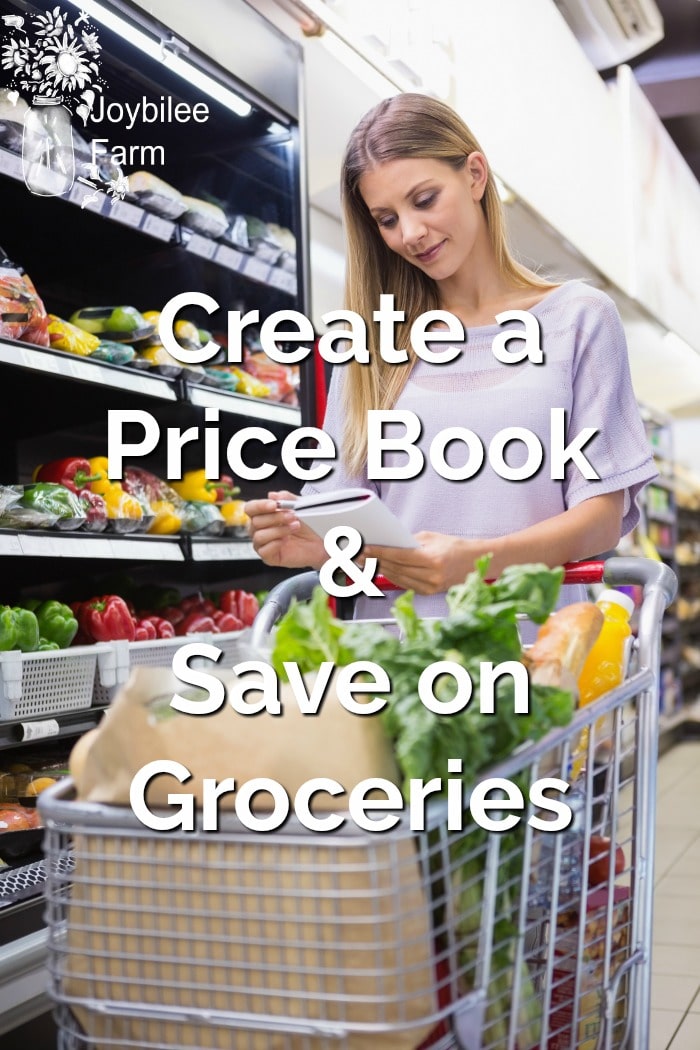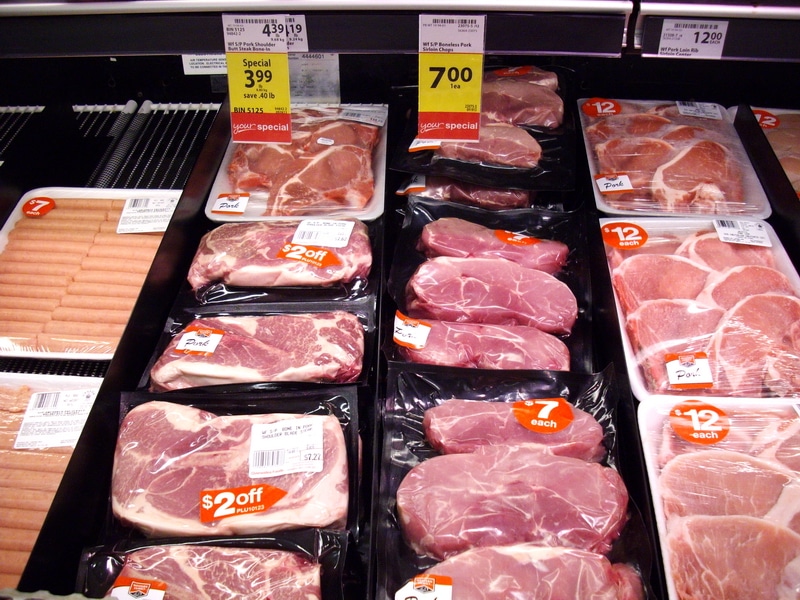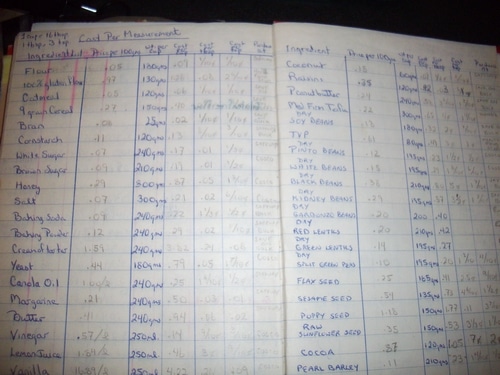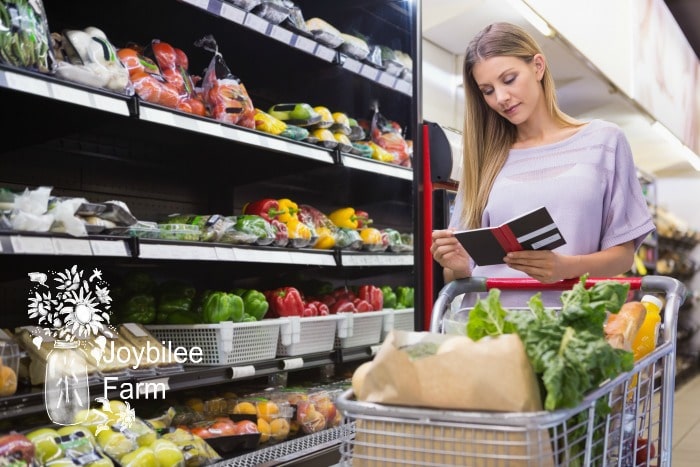Learn how to make a price book and track both regular prices and sales in your area overtime, so you know a bargain when you see one.
Why do you need a Price Book?
A price book gives you a record of the actual prices that you have paid for different commodities, reminds you of the usual sales price, and where you purchased the food.
I started my first price book in 1982, as a young bride. 1982 was the year of the RECESSION. Interest rates climbed so that my university student loan was negotiated at 24% interest. Fresh out of university, our first goal as a couple was to extinguish that student loan. The price book helped me to keep my frugal resolve and that ugly loan was fully paid off in 6 months.

I continued to keep my price book and although I’ve been lazy at times, the book has been there to bring a dose of reality to inflations ups and downs. In 1982, minimum wage was $3. per hour. Mr. Joybilee got his first job as an articling student in a Chartered Accounting firm, McKnight, Johnson, and Co. in Chilliwack at an annual salary of $14,000. He brought home about $1,200 a month, of which half went to the rent in our tiny 2 bedroom basement apartment. So that left about $600 to buy groceries, car insurance and repairs, gas, and utilities, pay our tithes and offerings, and the other things a newly married couple needs. My student loan was about $3,500 – which represented my final year of university – the first 3 years were paid for through working and going to school part time.
(So first of all, we actually DID pay off the student loan in 6 months. And no, it doesn’t work out on paper. I realize that. You see when you layout your finances before God and ask Him for help, He takes your natural and adds His supernatural to it. He has done this over and over again for us in our 30+ years of marriage. And so I offer it to you as an encouragement, when there doesn’t seem to be enough pay cheque at the end of your week.)
I learned to bake bread for the first time in 1982. I didn’t even own any bread pans but borrowed some pans from my landlady. I bought regular, bleached, all-purpose generic flour for $3.99 a bag, on sale. The Roger’s brand flour – unbleached, no additive whole wheat, my favorite flour — was $6.99 a bag regular price and rarely went on sale below $5.99. I didn’t touch it until my student loan was history.
A price book tells you if the price of food is increasing and the real-time rate of increase, in spite of what is reported in the media. The media cannot be trusted to accurately track trends in inflation.
For instance, in 2008, the media reported devastating inflation throughout the world. From January to September staples, like rice, tripled in cost and wheat flour, in many parts of the world doubled in price. In response, baked goods increased overnight, the bakery department in my local grocery store downsized by 50% while at the same time increasing their prices on ready baked breads, bagels, tortillas, and donuts. Sliced multi-grain bakery bread went from $2.99 a loaf to $5.99 at this time. It was a time of despair around the world, fueled by the media hype. Significantly, 5 years later, bread remains around $5.99 a loaf here and often drops to $4.00 a loaf on sale, in Western Canada. Prices do fluctuate regionally, so your price book will help you with the regional fluctuations in prices, too.
Commodity prices did go up in the Spring of 2008, while the new crop was growing. My price book reminded me that this is part of the normal annual price cycle. In September I bought 2 – 10 kg. (22 lb.) bags of my favorite brand of unbleached bread machine flour for $5.99 – just $2 more per bag than I paid for lesser quality generic bleached, all-purpose flour in 1982, the first year that I started keeping a price book. When the dust settled in January of 2009, the price of all-purpose flour had risen 10% over the previous 5 years average – keeping pace with the inflation rate. My price book showed both the fluctuations and depreciations in consumer prices, while the media only found the increased prices newsworthy, fueling panic.

A Price book becomes your memory
A price book reminds you of where you purchased food commodities and what prices that you paid, including the time of year, so that you can anticipate sales and plan them into your budget.
Sale prices go on an annual cycle. Usually when the new crop of any commodity comes in, products based on the old crop are discounted, to make room in warehouses for the new supply. In the Fall, canned goods – like canned beans, vegetables, and canned fruit will be discounted or some stores will have caselot sales. Frozen vegetables also go on sale at significant discounts to make room for the new harvest. This is a good time to stock up on sales for the winter.
I leave room in my food budget in September to November to purchase these discounts in quantity to add to my winter stores. My price book tells me when to anticipate specific sales. This is also the time of year when livestock goes to market and you will find good discounts in the meat department – pork loins, beef roasts, turkey and chicken, as well as soup bones and stewing hens. If you have a pressure canner, plan to make stocks and consommés, as well as canned meat, while the meat is in ample supply with attendant lower prices.
A price book helps you determine the cost of your recipes by serving size
A price book allows you to break down the actual cost of various recipes so that you can tweak recipes or accurately anticipate the costs when you are selling or donating food for bake sales or gifts. Sometimes it is more economical to give a cash donation than to donate food for bake sales at church or school and your price book will let you know when this is so.
Part of my price book is a breakdown of the cost per 100grams, the weight of 1 cup of the ingredient, and the breakdown of the cost per cup, cost per tbsp., cost per tsp. and also where I purchased it at that price. This helps me when making substitutions in recipes, and tells me whether some things are cheaper made from scratch or bought ready-made. Of course, it only counts the economic cost, not the health cost, nutrition cost, nor the time cost.
For instance, in 1990 – about 30 years ago — Flour was 4.99 for a 10kg bag of all-purpose flour at Safeway. This works out to 5 cents per 100 grams. 1 cup of flour weighed 180 grams and cost 9 cents a cup, 1/10ths cent per Tablespoon and per teaspoon.
In 1990 I was working on creating gluten free recipes to cope with my celiac disease, and the gluten free flour that I used was 97 cents per 100 grams, bought by the bag in the Health Food store. 1 cup of gluten free flour was 130 grams and cost me $1.26. 1 tablespoon was 8 cents, 1 teaspoon was 3 cents. When I made my own gluten free flour from brown rice flour (home ground), tapioca starch, and potato starch my cost per cup dropped to 30 cents from $1.26. While not as low as standard all-purpose flour, it made it more affordable for me to learn to bake gluten free for myself.
Without my price book, I wouldn’t have had a way to compare and wouldn’t have know if it was better to blend my own flour and bake gluten-free or to buy the ready made gluten-free products that my health food store carried. Which, by the way were rubbery and flavorless, not like what is available today.
How to make a price book
For my first price book, I divided the page into columns and used 1 row per ingredient/commodity. This allowed me to compare prices for ingredients based on current costs, but didn’t allow me to compare prices over the years. To do that I had to go back to my previous price books.
For that reason I suggest that you put only 1 ingredient commodity per page. If you need variations of the same ingredient – such as all-purpose flour, pastry flour, and whole grain flour – divide your page in half. Then use one row per item per shopping trip and record the prices both that you actually paid and even the sale prices that you find in the flyer but you didn’t buy.

Here is the price book I used in 1990. Today I put one ingredient per page. Same columns and categories.
Ideally I would use a hard bound, lined notebook, like people use to keep a journal. The pages don’t tear out easily and they will last you many years. If you have recipes that are staple in your family –like gluten free flour mix or a pancake mix, record those recipes in the back of the book, starting on the last page and moving toward the front. Under the recipe record the cost to make it—each time you make it – based on the current price of ingredients. This gives you a tangible way to compare prices over the years.
In the price book only keep track of the ingredients that you use all the time that you want to track over many years. You don’t need to record the box of ready-made cheese cake (24) that you bought at Costco for the office Christmas party/potluck – if it’s a one-time purchase. Record it only if it’s a regular part of your monthly or seasonal shopping.
| Ingredient | Date | Bought at | Price | Price/100g | Wt./c. | Cost/c. | Cost/tbsp. | Cost/tsp |
| Ex. Flour | 9/13 | Save-On | 12.89/10k | 13 cents | 180gm | 23 cents | 2 cents | 1 cent |

For calculation purposes:
- There are 16 tablespoons in a cup.
- There are 3 teaspoons in a tablespoon
- Round your cash up to the nearest 1 cent.
A price book doesn’t keep track of your spending, in the same way a budget does. A price book instead, helps you keep track of costs so that fluctuations in prices are predictable and you are able to easily adjust.
Your Turn:
A personal price book helps you track sales and inflation letting you know at a glance, if a sale price is actually a bargain. It also lets you determine the actual cost per serving of your recipes. Do you keep a price book? If not you can begin today. All you need is a journal and a pen.



A price book really appeals to the analytical/frugal side of me. I have several blank book type journals that were given to me as gifts. Now I know what I will do with one of them. ✏️ Long ago, when I first started doing my own grocery shopping I made a list of frequently purchased items and took it to all 3 grocery stores in my area to compare prices. I was less concerned about ads and sale prices on individual items than I was about what the overall cost of my average bill would be. It was a good exercise and I learned from it. Now I wish I had been keeping a price book all these years. It would be so interesting to go back and compare! Well, I can begin now, so I will. Thanks again, I really enjoy your website.
Great idea! And so much more useful than the usual clipped coupon book I used to read about when looking for ways to save . . . . Most of my shopping now I do online in bulk quantities and I keep a lot of the data in spreadsheets that I’ve added to over the years. I usually set my criteria for what I want to purchase at the beginning and list date, product, vendor, weight, price, shipping, price per unit with shipping calculate in, and any notes about the price or product that are incidental to the purchase — for instance, that this is a sale price at this time, so I know next time I’m ‘shopping’ to double check for a new cost. // It occurs to me that an iPad with a spreadsheet program (is there such a thing? there must be!) would be worthwhile, very 21st century and all that, with the ability to carry it around easily in a store, consult for current prices elsewhere, and so on and so forth.
(I want to add one personal note, which you may delete if you wish. Your comment about working to find things to cope with your celiac disease gives me an even greater appreciation of your work and what you offer your readers/supscribers/customers. I was a Registered Dietitian and counselled celiac patients. At one point I even had that diagnosis hanging over me for three years and I was so glad I had studied the right subject to be able to get a truly gluten free diet done correctly. Mind you, this was something like 40 years ago, long before “gluten free” became stylish and gluten-free products became relatively easy to find. (I got up my courage, finally, and had the biopsy that determined I was NOT celiac, but sister, let me tell you, I had learned a lot! Some years later I received a medical diagnosis that explained my funny insides but that’s a whole other story.) I am seriously annoyed by the popular ‘gluten free diet’ craze which to my mind detracts from the seriousness of real celiac disease with respect to those who suffer from it. )